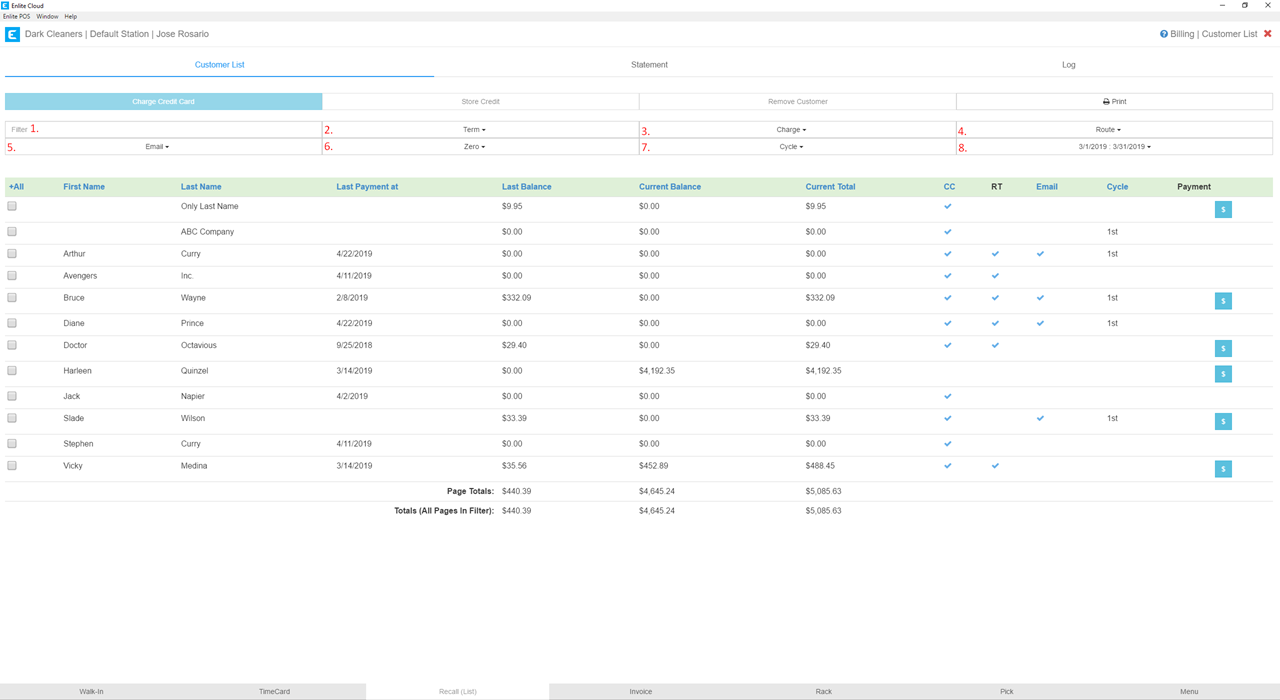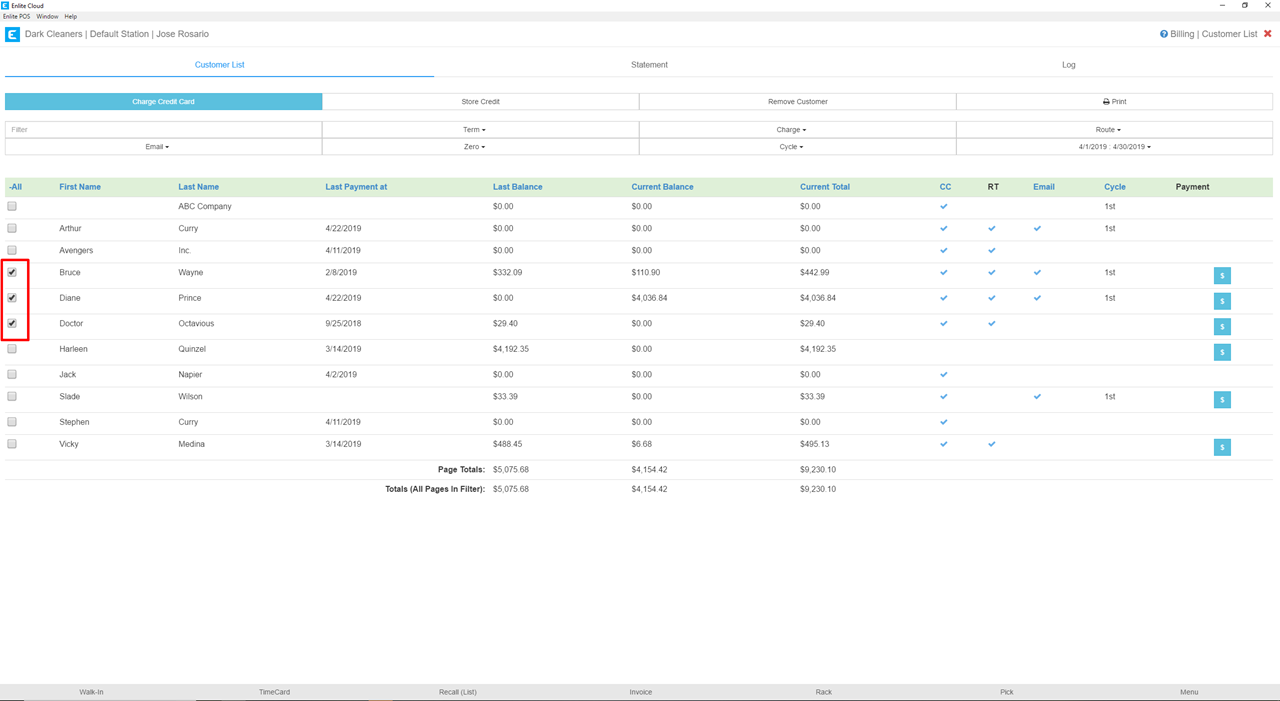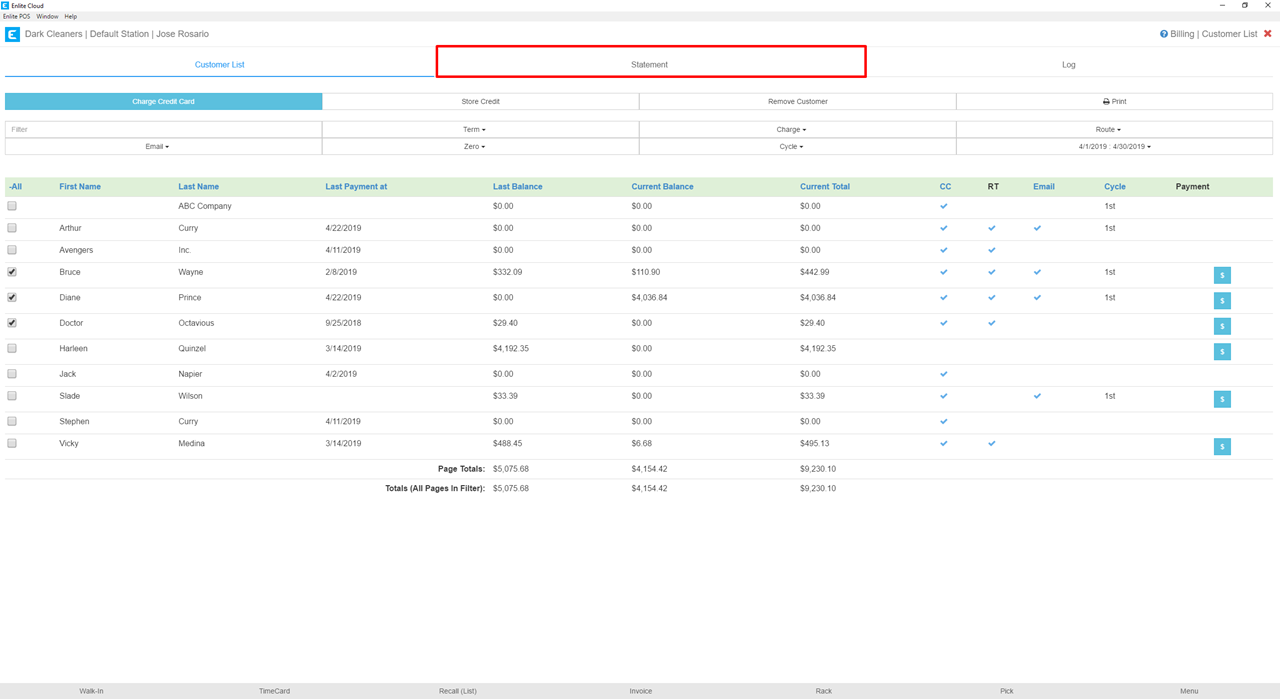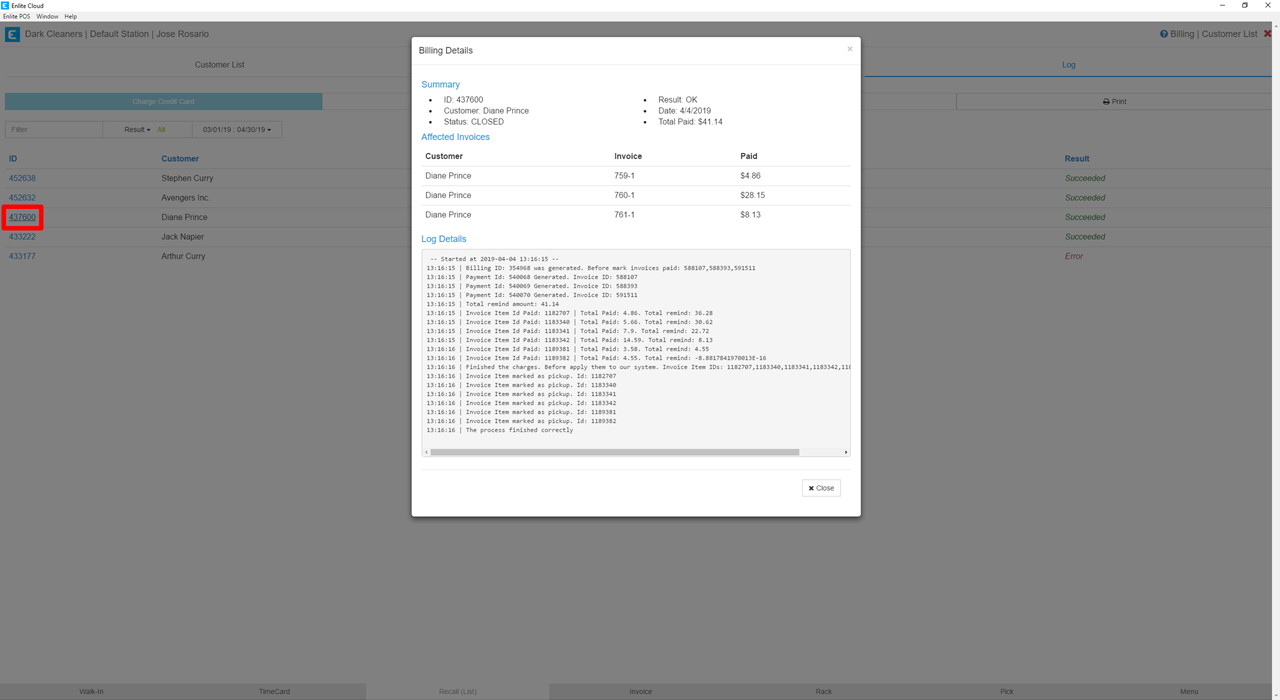Batch Billing allows you to bill multiple customers at one time. Generally, these are customers who are billed in regular periods that extend beyond a single visit, for example, weekly, or monthly.
-
The billing module provides several tools to manage the list of customers you want to bill. The numbered items explained below correspond to the numbers in the picture, indicating their position on the screen.
-
Filter: Search for any customer by their name, the list will dynamically change to show matching results as the search text is entered.
-
Term: Search for customers' payment terms, Net 10, Net 15, Net 30, etc.
-
Charge: Show customers who are charge only, in other words, customers whose credit cards you have stored. Note that this does not necessarily mean that the card is stored in Enlite. See the Adding Customers to Billing (https://help.darkpos.com/hc/docs/articles/how-to-add-customers-to-billing) knowledge base article to find out how to designate a charge customer.
-
Route: Show only customers who are, or are not assigned to a route. See the Adding Customers to Routes (https://help.darkpos.com/hc/docs/articles/adding-customers-to-routes-from-customer-profile) for how to do this.
-
Email: Show customers who prefer to receive their statements via email. See the Adding Customers to Billing (https://help.darkpos.com/hc/docs/articles/how-to-add-customers-to-billing) knowledge base article to find out how to set this preference for a customer.
-
Zero: Show or hide customers with a 0 balance.
-
Cycle: Filter customers by cycle date, for example, show only customers billed on the 1st of the month. See the Adding Customers to Billing (https://help.darkpos.com/hc/docs/articles/how-to-add-customers-to-billing) knowledge base article to find out how to set a customer’s cycle date.
-
Billing Period: Set the billing period that you will use to bill your customers. Note that by default, the period is always set to the previous month. Adjust the starting and ending dates to capture the invoices and charges that will be included in this billing period. You may set any period you like.

-
Set your billing period. This is the most important step. The billing period will capture the invoices and charges that are included in the statement and affects the Last Balance, Current Balance and Current Total fields that make up the amount the customer will be billed.
-
Last Balance: Includes any charges owed PRIOR to the billing period that has been defined. In the case below, Bruce Wayne has $332.09 that he incurred prior to the 04/01/2019 billing period start date that has been defined. These charges will appear under Previous Balance on the customer’s statement.
-
Current Balance: Includes any charges owed WITHIN the billing period that has been defined. In the case below, Bruce Wayne has incurred $110.90 at some point between the 04/01/2019 thru 04/30/2019 billing period that has been defined. These charges will appear under Current Balance on the customer’s statement and all the invoices falling into the current balance will be detailed so the customer can review the charges.
-
Current Total: Total of all charges incurred PRIOR to and WITHIN the billing period that has been defined. In the case below, Bruce Wayne incurred $332.09 PRIOR to the 04/01/2019 billing start date and has also incurred $110.90 during the billing period (04/01/2019 thru 04/30/2019). So, his Current Total is $442.99 which is the sum of his Last Balance and his Current Balance. The Current Total will appear as the Total Amount Due on the customer’s statement.

- Select customers to Bill. By checking the names of the customers, they will be selected to be billed and their statements will be generated. It is our recommendation to not batch bill more than 15 customers at a time. We have seen that with numbers larger than this, users begin to make mistakes and once they are made they are not easy to correct. From this module, you will be marking numerous invoices as paid with the touch of a button. Proceed carefully. If you are new to this module, begin with 5 or 10 customers at a time until you are confident in your actions. In the example below, we have selected 3 customers to be billed.

- Viewing Statements. To view the statements belonging to the selected customers, click on the Statement tab. Note that if you do not select customers, you will not see statements.

-
Statements will be generated for all the selected customers. They will be generated on the same screen one after the other. From the Statement page, several actions can be taken:
-
Email: Email an individual statement. This is done by clicking the email button INSIDE the statement.
-
Export CSV: Export an individual statement to a CSV file. This is done by clicking the Export CSV button INSIDE the statement.
-
Email All Statements: For the customers, you have generated statements, you can email all the statements at one time by pressing the Email All Statements button.
-
Print: For the customers, whom you have generated statements, you can print all the statements at one time by pressing the Print button.
-
Charge Credit Card: This is the last action you will take on this screen. Once you have reviewed the statements and the charges and emailed or printed them, you can charge all the selected customers at one time by pressing the Charge Credit Card button. In order to do this, you must be integrated with a payment processor so that Enlite may perform this action. Once the button is pressed the customers’ credit cards will be charged for their corresponding amounts and update all the invoices to reflect the payment that was made. It is important that you print or email your statements PRIOR to pressing this button because balances will be recalculated after the payment has been processed.

7 . Reviewing Batch Credit Card Transactions. From the Log section, you can see the result of every credit card transaction that was processed. Again, in order for this to work your payment provider must be integrated with Enlite. On this screen, you can see the amounts that were billed, the date and time and the Result. Depending on your payment provider, if the transaction failed, you will receive a descriptive error message, such as credit card expired, so that you may contact your customer with the reason the charge failed. This varies by the payment processor.

8 . By clicking on an ID, you can see more information relating to the amount that was billed, including the invoices that make up the amount and a transaction number that corresponds with the payment processor in case the payment needs to be individually identified. Again, in order for this to work your payment provider must be integrated with Enlite.

9 . One more place where you can check the results of your batch credit card billing is in the Reports section. The Log section is useful to check one user quickly, but to see the results if you’ve batch billed 100+ customers, it’s easier to do so in the Reports section. You can access this in the Back Office (Pic 8.1). Under the Report Type: 5. Payments, there are 3 key reports (Pic 8.2)
A. Audit Billing – Shows summary results for every billing payment entered for a specified period
B. Audit Billing Details – Shows detailed payment results for every billing payment entered for a specified period
C. Audit Billing Errors – Shows Billing transactions that resulted in an error
The Audit Billing Errors report is particularly useful because it will list all the customers whose credit cards returned an error (Pic 8.3). Depending on your payment processor, the error may be shown in the results, for example, credit card expired, credit card overdrawn, credit card stolen, etc. Not all payment processors return a user-friendly error. But at the very least, this report will show every customer that needs to be contacted because their credit card was declined.
Pic 8.1

Pic 8.2

Pic 8.3
